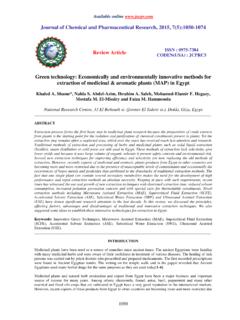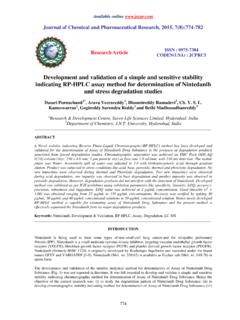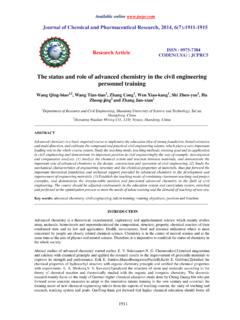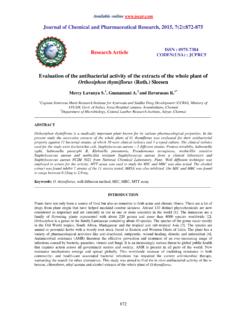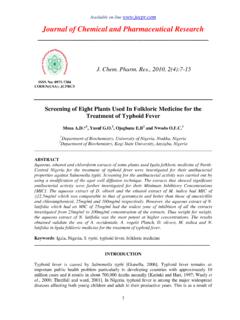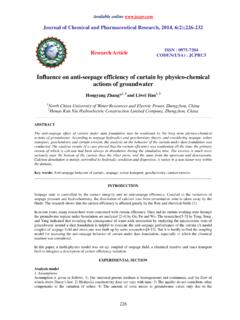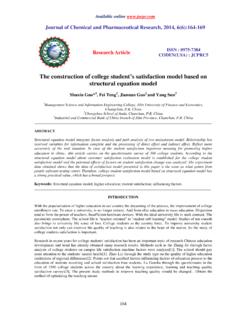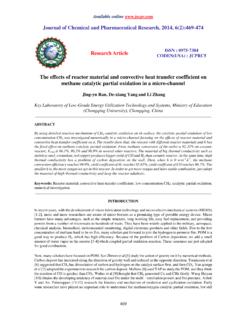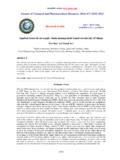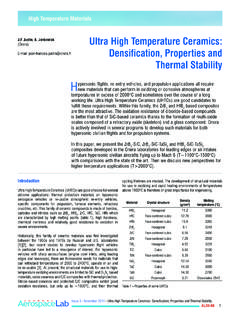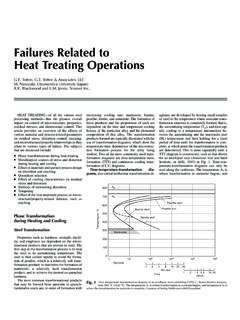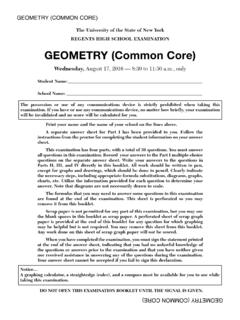Transcription of Journal of Chemical and Pharmaceutical Research
1 Available on line Journal of Chemical and Pharmaceutical Research _____ ISSN No: 0975-7384 CODEN(USA): JCPRC5 J. Chem. Pharm. Res., 2010, 2(3):478-483 478 Synthesis of silver nanoparticles: a safer alternative to conventional antimicrobial and antibacterial agents Amrut S. Lanje1,*, Satish J. Sharma2 and Ramchandra B. Pode3 1 Department of Electronics, Dr. Ambedkar College, Chandrapur, India 2 Department of Electronics, R .T. M. Nagpur University, Nagpur, India 3 Department of Physics, Kyung Hee University, Seoul, Korea _____ ABSTRACT We present the synthesis of spherical silver nanoparticles by simple and low cost Chemical route.
2 Well-dispersed silver nanoparticles were prepared by reducing silver nitrate (AgNO3) with glucose in presence of protective agent polyvinyl pyrrolidone (PVP). Sodium hydroxide was used to enhance the reaction velocity. The prepared nanoparticles were characterized by X-ray diffraction (XRD), scanning electron microscopy (SEM) and transmission electron microscopy (TEM). XRD pattern showed the face centered cubic structure of silver nanoparticles. The crystallite size was found to be 18 nm using Scherrer formula. The spherical morphology of silver nanoparticles was confirmed from SEM image.
3 The transmission electron microscopy (TEM) image showed the average particle size of silver nanoparticles was about 15 nm. Silver nanoparticles can kills bacteria when spreads on shoes, socks, phone and even computer keyboard. A preliminary test shows that silver nanoparticles are highly active against S. aureus, E. coli, and P. aeruginosa. This reveals that silver nanoparticles could provide a safer alternative to conventional antimicrobial and antibacterial agents. Keywords: Silver; Nanoparticles; Antimicrobial; Antibacterial. _____ INTRODUCTION Metal nanoparticles have attracted much attention in the fields of physics, chemistry, electronics and biology [1-3] because of their unique electrical [4], Chemical [5], optical [6] and photo-electrochemical [7] properties, which are strongly dependent on the sizes and shapes of metal nanomaterials [8 12].
4 Metal nanoparticles have a high specific surface area and a high surface to Amrut S. Lanje et al J. Chem. Pharm. Res., 2010, 2(3):478-483 _____ 479 volume ratio. Nanostructured noble metals are potentially used in catalysis, optoelectronics, microelectronics etc. Metal nanoparticles are particularly interesting systems because of the ease with which they can be synthesized and modified chemically [13, 14]. Silver particles play an important role in an electronic industry. In recent years, with higher integrated density of the electronic components (small size and precision of the electronic components), there is growing demand for a thin conductive films and a further reduction in printed circuits.
5 Powders of nanoparticles form the conductive films and thereby reducing the dimensions of the printed circuit [15]. Silver has been known to have antibacterial properties since ancient times. Many new industries involves in production of antibacterial gels using silver nanoparticles [16]. Recently, it was found that aqueous chloroaurate ions may be reduced extracellularly to generate extremely stable gold or silver nanoparticles in water. These particles can be incorporated in materials and cloth becoming them sterile. The sterile materials are important in hospital, where often wounds are contaminated with microorganisms [17].
6 Silver nanoparticles acts like antimicrobial agents to reduce or prevent infections. [18]. Ag nanoparticles can be used as effective growth inhibitors in various microorganisms, making them applicable to diverse medical devices and antimicrobial control systems. The antimicrobial effects of silver (Ag) ion or salts are well known, but the effects of Ag nanoparticles on microorganisms and antimicrobial mechanism have not been revealed clearly. This paper presents the synthesis of spherical silver nanoparticles by simple and low cost Chemical route. A preliminary test shows that silver nanoparticles are highly active against Staphylococcus aureus, Escherichia coli, and Pseudomonas aeruginosa and could act as a safer alternative to conventional antimicrobial and antibacterial agents [19-20].
7 EXPERIMENTAL SECTION The Chemical reduction method is one of the commonest methods to synthesize colloidal metal particles because of its convenient operation, ease of control and simple. We have used Chemical reduction method to synthesize the silver nanoparticles. Well-dispersed silver nanoparticles were synthesized by reducing silver nitrate (AgNO3) with glucose in presence of protective agent PVP. Sodium hydroxide (NaOH) is used to enhance the reaction velocity. Chemical Reagents All the chemicals used in the experiment were analytical reagent (AR) grade. Silver nitrate (AgNO3) was provided by Glaxo SmithKline Pharmaceutical Ltd.
8 Glucose and PVP were obtained from Merck. The sodium hydroxide (NaOH) pellets was purchased from Loba Chemie. Deionized water was used through out the experiment. Preparation g of PVP, g of NaOH and g of glucose were dissolved in 15 ml deionized water and heated to 60 C with constant stirring. M (in 5 ml water) of silver nitrate solution was added to PVP solution drop by drop. After all the silver nitrate solution is added, the solution was further stirred for 10 min. The particles were separated by centrifugation and washed with distilled water several times until no NO3 could be traced.
9 The particles were dried at 80 C. Grey colored silver nanoparticles were obtained in the form of powder. Figure 1 shows the flowchart for the preparation of silver nanoparticles. Amrut S. Lanje et al J. Chem. Pharm. Res., 2010, 2(3):478-483 _____ 480 Figure 1: Flowchart for the preparation of silver nanoparticles. Characterization of Silver nanoparticles The powder X-ray diffraction (XRD) was performed using Philips Holland, XRD system PW 1710 with nickel filtered CuK ( = ) radiation. The average crystallite size (t) has been calculated from the line broadening using the Scherrer s relation: t = /Bcos , where is the wavelength of X-ray and B, the half maximum line width.
10 The scanning electron microscopy (SEM) studies were performed with JEOL JSM 5600. The transmission electron microscopy (TEM) studies were performed with Tecnai 20 G2 under 200 KV. Samples are prepared by dispersing drop of colloid on copper grid, covered with the carbon film and the solvent is evaporated. RESULTS AND DISCUSSION XRD study Figure 2 (a) shows the X- ray diffraction pattern (XRD) of as prepared silver nanoparticles synthesized using Chemical reduction method. A number of Bragg reflections corresponding to the (111), (200), (220), (311) and (222) sets of lattice planes are observed.
